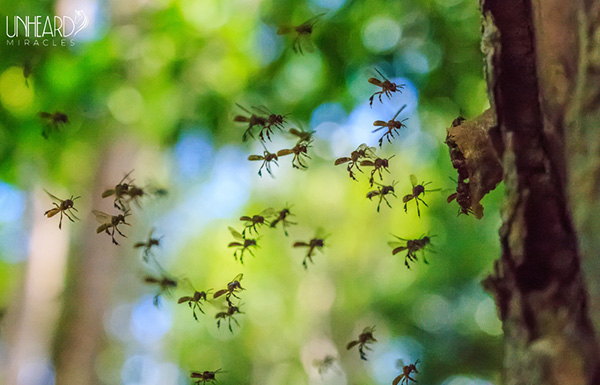In the world of honeybees, how bees communicate is not just a necessity but a wonder of nature. These fascinating insects have intrigued scientists and nature enthusiasts with their unique ways of communication. From their smooth waggle dance to gentle vibrations and complex chemical signals, bees have developed amazing methods to navigate their environment and help their colonies thrive.
Understanding how honey bees communicate not only reveals their social complexity but also highlights their crucial role in ecosystems worldwide. Exploring their communication methods gives us a deeper appreciation for their intelligence and the teamwork they demonstrate every day.
How Do Bees Communicate With Each Other?
Communication is essential for bees to collaborate effectively, find food, and coordinate hive activities. Can bees talk? Honey bees use several sophisticated methods to share information within their colony:
1. The Waggle Dance
When a bee finds a food source, it performs a waggle dance. This dance, resembling a figure-eight pattern, involves the bee shaking its bottom. This movement tells other bees where the food is and how far away it is. The angle of the dance indicates the direction, while the duration of the bee’s waggle communicates the distance.
2. Chemical Signals
Bees also use pheromones—chemical signals secreted by glands—to communicate. For example, the queen bee releases pheromones that help regulate the behavior and development of other bees in the hive. Alarm pheromones are released when a bee feels threatened, prompting the colony to become defensive.
3. Vibrational Signals
In addition to dances and chemical signals, honey bees produce vibrational signals. These vibrations can communicate different needs or warnings. For instance, during swarming, bees create a specific type of vibrational signal that helps coordinate the departure of the swarm from the hive.
4. Tactile Communication
Bees engage in tactile communication through physical contact. This form of communication can involve grooming, touching, and even pushing. Such interactions help strengthen social bonds within the colony and ensure cooperation among bees.
Through these complex and varied methods, honey bees effectively share information and work together to maintain their colony’s health and productivity.
What Sound Does a Bee Make?
Bees don’t just communicate through dance; they also use sound to convey their messages. The buzzing noise you hear from bees comes from their wings. This buzzing can signal different things depending on the situation. For example, it might indicate that a bee is excited, feeling threatened, or trying to alert others to danger. This buzzing helps bees share important information and coordinate their activities within the hive.
How Do Bees Procreate?
Bee reproduction is a fascinating process that’s crucial for the survival and growth of the colony. Here’s a closer look at how it works:
Queen Bee’s Role in Reproduction:
The queen bee plays a crucial role in bee reproduction. She can choose to lay eggs that will become female worker bees, future queens, or male drones. Before laying eggs, she goes on a mating flight, where she mates with many male drones. During these flights, she stores sperm from the drones in a special part of her body called the spermatheca. This stored sperm is used throughout her life to fertilize eggs and maintain the colony’s population.
Mating Flight and Drones:
Male drones gather in specific areas in the sky called drone congregation areas. When a young queen bee is ready to mate, she flies to these areas and mates with multiple drones. Each drone transfers sperm to her during mating. Unfortunately, after mating, the drone dies because his endophallus is torn off. This sacrifice ensures the queen has enough sperm to fertilize thousands of eggs.
Egg Laying and Brood Development:
After mating, the queen returns to the hive and starts laying eggs. She decides whether to fertilize the eggs or not, depending on the colony’s needs. Fertilized eggs develop into female worker bees or potential new queens, while unfertilized eggs become male drones.
Worker Bee Care:
Worker bees take care of the eggs and larvae. They feed the young bees different kinds of food depending on whether they are destined to be queens, workers, or drones. This special diet helps them grow into their roles within the colony.
In this way, bees ensure their colony continues to thrive through careful reproduction and division of labor among their members.
Conclusion
Studying how bees communicate reveals their social organization and amazing adaptations. Their ability to share exact information through dance, sound, and chemical signals highlights their intelligence and teamwork. Besides sustaining their colony, bees are vital to ecosystems through pollination and other key roles.

Thanks for sharing. I read many of your blog posts, cool, your blog is very good. https://www.binance.com/id/register?ref=GJY4VW8W